Performance management planning is a strategic process used by organizations to set goals, evaluate the performance of employees, give feedback, and plan for development in order to enhance efficiency. It also aids in boosting employee engagement, development and overall organizational success.
What is Performance Management Planning?
Performance management planning simply entails defining goals and expectations for staffs; setting standards against which accomplishments are measured; and giving advice that will help them improve.
Key processes involved in planning performance management
- Objective Setting: The first step in the process of performance management planning is to define precise, measurable targets for employees. Specifically, these goals should be set as SMART- specific, measurable, attainable, relevant and time-based – so as to give the necessary direction.
- Monitoring Progress: After setting goals it is important to monitor and track their progress on a continuous basis by employees. This can be done through regular check-ins, performance reviews and feedback sessions aimed at ensuring that they are on track towards achieving their objectives.
- Giving Feedback: Feedback is an integral part of performance management planning. Managers must deliver constructive advice to individuals regarding their performances and emphasizing some strong areas of improvement. Arriving at this point enables one to realize his or her position hence enhancing effectivenes.
- Appraising Performance: By the end of a given period of service delivery, it is crucial to evaluate how well employees performed against established targets. In this regard such evaluations will identify high achievers together with those who need further development besides informing strategic talent planning within an organization.
Table of Contents
Best Practices for Effective Performance Management Planning
To ensure the success of the performance management planning process, organizations should follow these best practices:
- Establish clear and transparent communication channels between managers and employees.
- Help workers succeed in their performance goals through training and resources.
- Make performance objectives periodic by reviewing and modifying them with changing business requirements.
- As a way of motivating employees, create an atmosphere of constant feedback and appreciation.
- Investment in performance management tools and technologies can help simplify the process.
"Effective performance management planning is the key to unlocking the full potential of your employees and driving organizational success."
How to Develop an Effective Performance Management Plan for Employees in Your Organization
Developing an effective employee performance management plan is about giving clear goals, continuous feedback, and fostering progress. The main components are setting measurable targets, ongoing training, periodic reviews, and acknowledging achievements. It improves individual performance as well as links their efforts with the company’s strategic objective leading to success in general.
Setting Organizational Goals
Setting organizational objectives holds massive significance for any business operating within a dynamic business landscape. It starts by defining definite, measurable, achievable realistic time-bound goals that fit into your broad mission and vision. When you have precise objectives in place you give yourself a route map towards success while also increasing focus and eliminating diversions hence boosting productivity.
Aligning Goals with Company Mission and Vision
Aligning goals with corporate missionThe goals that you set should resonate with your company’s mission and vision to be effective and meaningful. This alignment motivates your team, fostering a sense of purpose and direction. Leaders should articulate these goals clearly and frequently, ensuring that every team member understands how their efforts contribute to the company's overarching objectives. This practice not only enhances engagement but also ensures that your team is working towards common objectives, thus promoting a unified effort.
In this process, frameworks such as O.K.R. (objectives and key results) can be critical.Ensuring that they complement the company’s vision and mission among other things is enabled by this framework in aligning goals at different levels of the organization.In addition to this, using Backwards Goal Framework can breakdown important steps into small pieces making it easier for your journey towards achievements.
Implementing Effective Goal-Setting Frameworks
Getting the right goal-setting framework is vital to the achievement of your organizational goals. All these frameworks like SMART goals, OKRs, and Goals Pyramid Framework among others, are aimed at organizing your objectives so that they become more clear and achievable. They make it easy to break down big goals into smaller tasks thus making it manageable and actionable.
For instance, Balanced Score Card (B.S.C.) will ensure that there is a strategic alignment in all operational activities hence ensuring all levels of organization contribute towards a common objective. It not only ensures that your team stays on track but also balances progress within different aspects of an organization.
Moreover, fostering adaptability and flexibility in your team is critical. Your goals may change depending on the business environment you operate in. Building these capacities within your teams therefore makes sure that even as circumstances change, the organizational objectives remain attainable.
In conclusion, organizational goal setting does not only involve stipulating what needs to be accomplished by the company but also entails creating a comprehensive mechanism that links up these targets with the corporate mission and vision; implementing effective goal-setting frameworks; adapting to changing conditions
"Effective performance management planning is the key to unlocking the full potential of your employees and driving organizational success."
Developing a Performance Management Framework
The development of an effective Performance Management Framework is significant as it aids in matching worker’s performance with organizational objectives, hence improving productivity and employee commitment. Typically, such a framework must have some important constituents like the most suitable performance management model as well as identifying relevant performance metrics.
Choosing a Performance Management Model
Choosing a performance management model that best suits your organization’s culture, goals, and operational dynamics is important. Different models offer various approaches and advantages:
- Self-Renewing Cycle: This model emphasizes continuous planning, reviewing, and supporting employees in their development, making it ideal for organizations that value ongoing employee growth and adaptation.
- Management by Objectives (MBO): Focuses on setting organizational objectives that guide individual employee goals, fostering clarity and employee participation in the goal-setting process.
- Employee-Driven Model: Enhances engagement by involving employees in the performance management process, which can lead to more tailored and effective development programs.
- Software-Based Model: Utilizes dedicated software solutions to streamline the performance management process, offering tools for efficiently tracking and analyzing performance data.
- Peer-Reviewed Model: Involves employees in evaluating each other's performance, promoting a collaborative and continuous feedback culture.
- Bi-Annual Model: Suitable for organizations with long-term goals, allowing for periodic adjustments to align with evolving organizational needs.
- Continuous Model: Replaces traditional appraisals with ongoing conversations, which can be particularly valuable in dynamic environments where rapid adaptation is crucial.
Aligning the chosen model with your company's strategic goals ensures that every employee's efforts contribute directly to the company's broader objectives. This strategic consistency enhances focus and motivation and facilitates better decision-making and measurable results.
Identifying Relevant Performance Metrics
Selecting the right Key Performance Indicators (KPIs) is critical to driving organizational performance and ensuring that employee behaviors align with strategic goals. The following principles can guide the selection of effective KPIs:
- Simplicity and Clarity: KPIs should be easy to understand and measure, ensuring that all employees are clear about what is expected of them.
- Relevance: Choose KPIs that are directly related to your strategic goals to maintain focus on what is most important.
- Balance: It's essential to balance leading indicators (which can predict future performance) and lagging indicators (which measure outcomes) to get a comprehensive view of performance.
- Adaptability: KPIs should remain relevant over time and adaptable to changing business conditions.
For instance, if improving customer satisfaction is a goal, relevant KPIs might include customer satisfaction scores and net promoter scores, which provide direct feedback on customer experiences.
By carefully choosing a performance management model and identifying relevant KPIs, you can create a performance management framework that not only aligns individual and team performance with organizational objectives but also supports continuous improvement and development. This strategic approach is essential for fostering a motivated workforce and achieving sustained organizational success.
Leveraging Technology in Performance Management
In the current evolving business environment, leveraging technology in managing performance is a necessity for efficiency improvement and strategic growth.
Benefits of Performance Management Software
Performance appraisal software is a multifaceted way of knowing and improving the capabilities of staff. Applying this kind of technology gives you great ideas about your staff’s strengths and weaknesses through detailed data analysis, enabling better decision-making. This software also supports HR teams by automating routine activities, organizing digital records, and enabling easier access to employee performance data. These advantages include providing instant responses on time to employees which are vital for their development and morale.
"Effective performance management planning is the key to unlocking the full potential of your employees and driving organizational success."
Managers can customize job positions to leverage individual strengths if they identify areas where employees succeed or underperform thus, increasing productivity while ensuring job satisfaction at the same time. Moreover, the ability to rapidly identify and rectify performance issues helps maintain high standards of work quality, and fosters team cohesion
Features to Look for in Performance Management Tools
Picking a suitable performance management tool requires looking at the features that are in line with company needs and boosting the performance management process. Some of the key functions to consider include:
Automated Performance Reviews: Tools that automate the review process save time and ensure consistency in how performance data is collected and analyzed. This feature allows for timely feedback and simplifies the evaluation process.
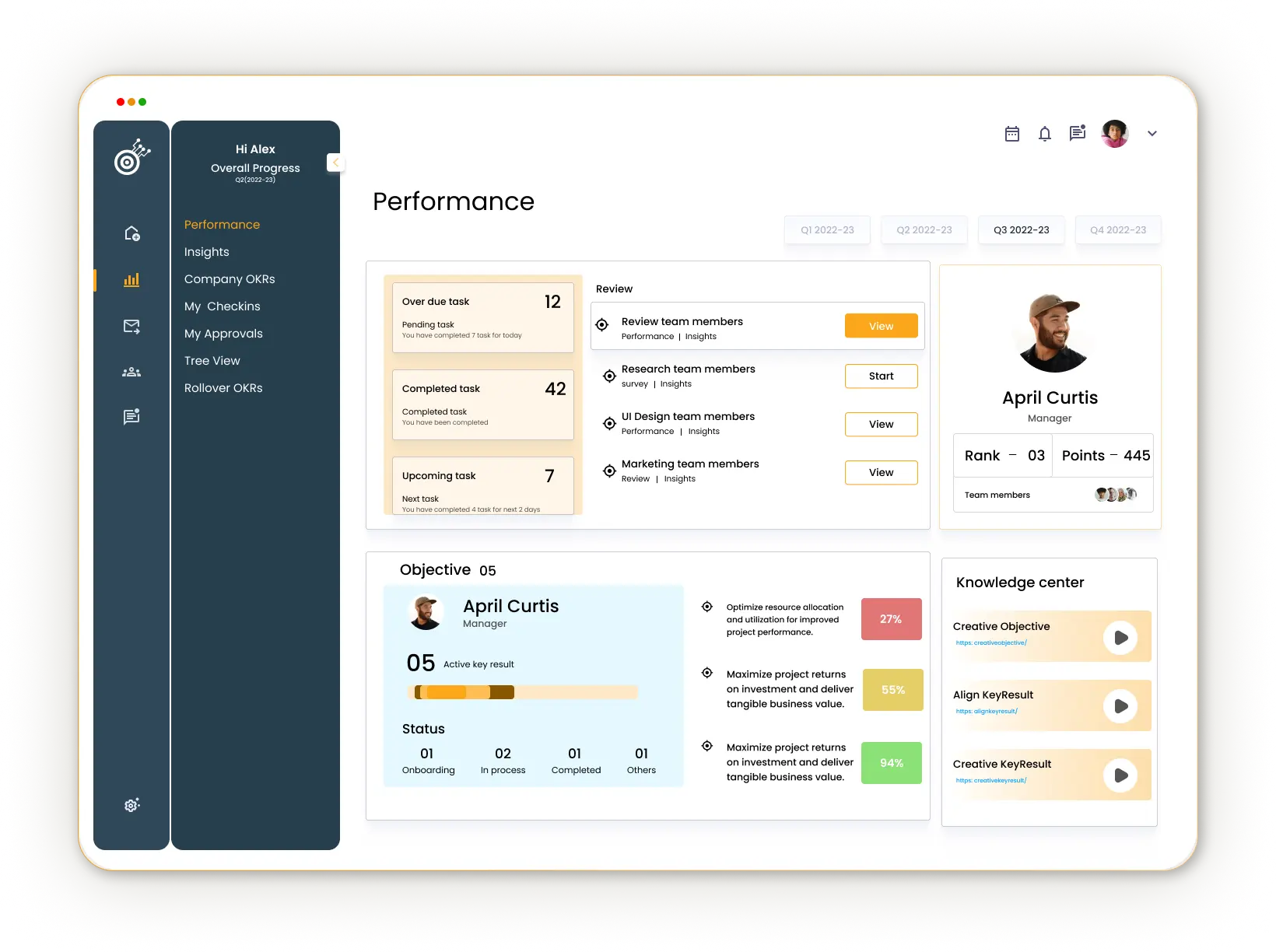
Goal Management: Effective tools help align individual performance with organizational goals. Look for systems that allow for easy setting, tracking, and updating of performance targets that support the overall business strategy.
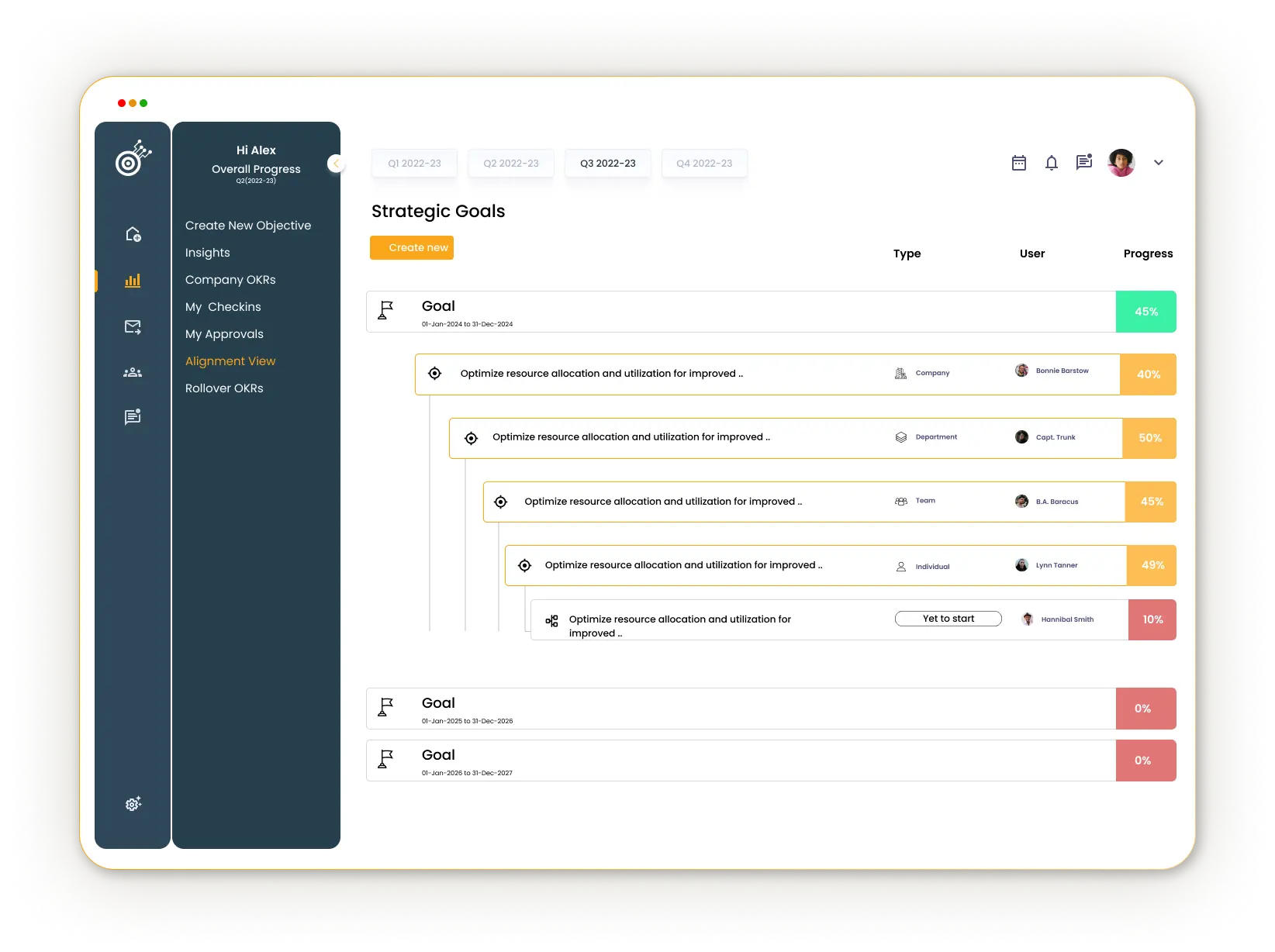
360-Degree Feedback: Incorporating feedback from a variety of sources, including peers, managers, and direct reports, provides a well-rounded view of employee performance. This feature enhances the accuracy of performance assessments and supports comprehensive development plans.
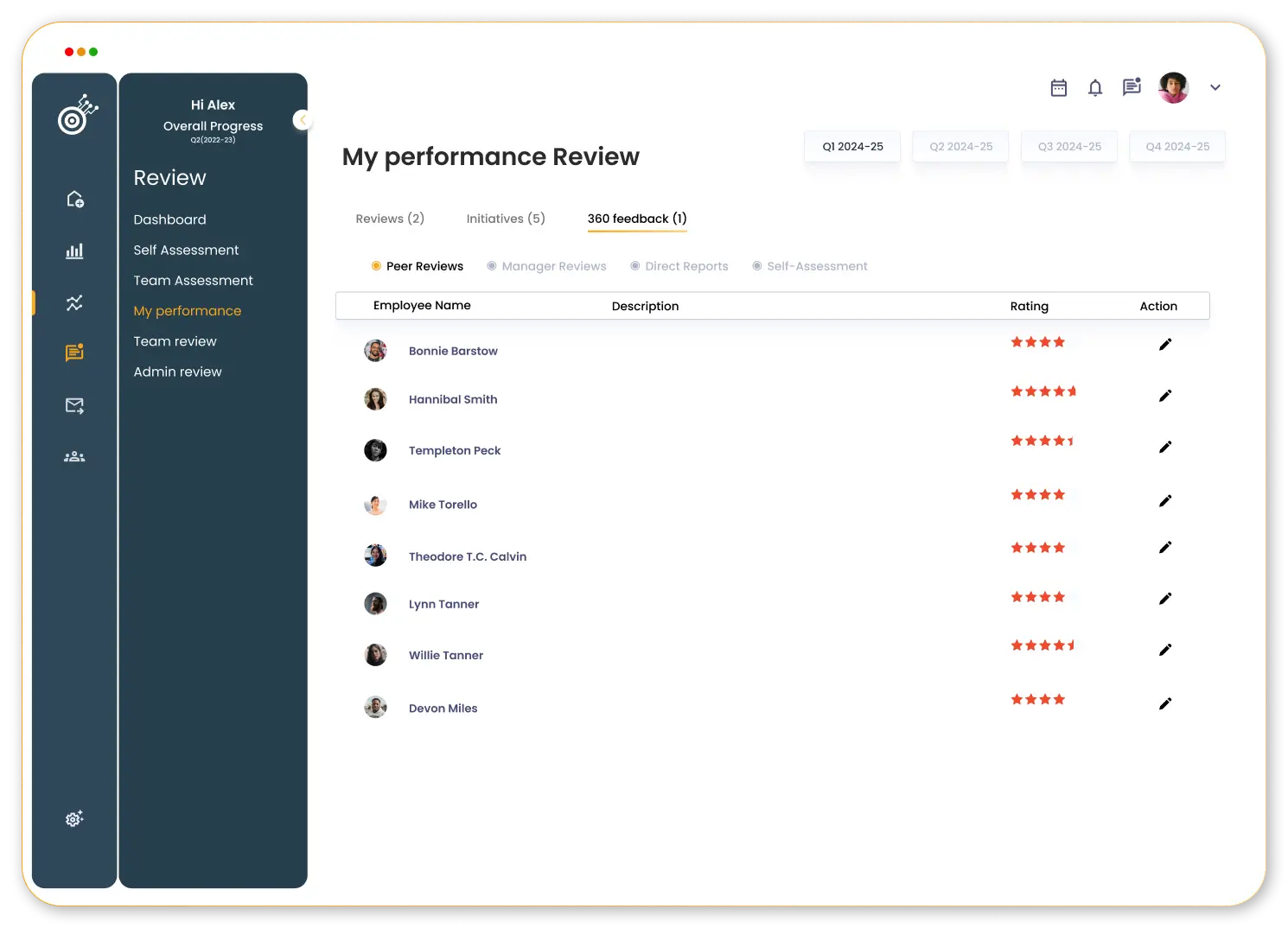
Real-Time Analytics and Reporting: Advanced analytics help track performance trends and make proactive adjustments. Tools that offer customizable reports and real-time data can significantly impact decision-making processes by providing insights into both individual and team performance.
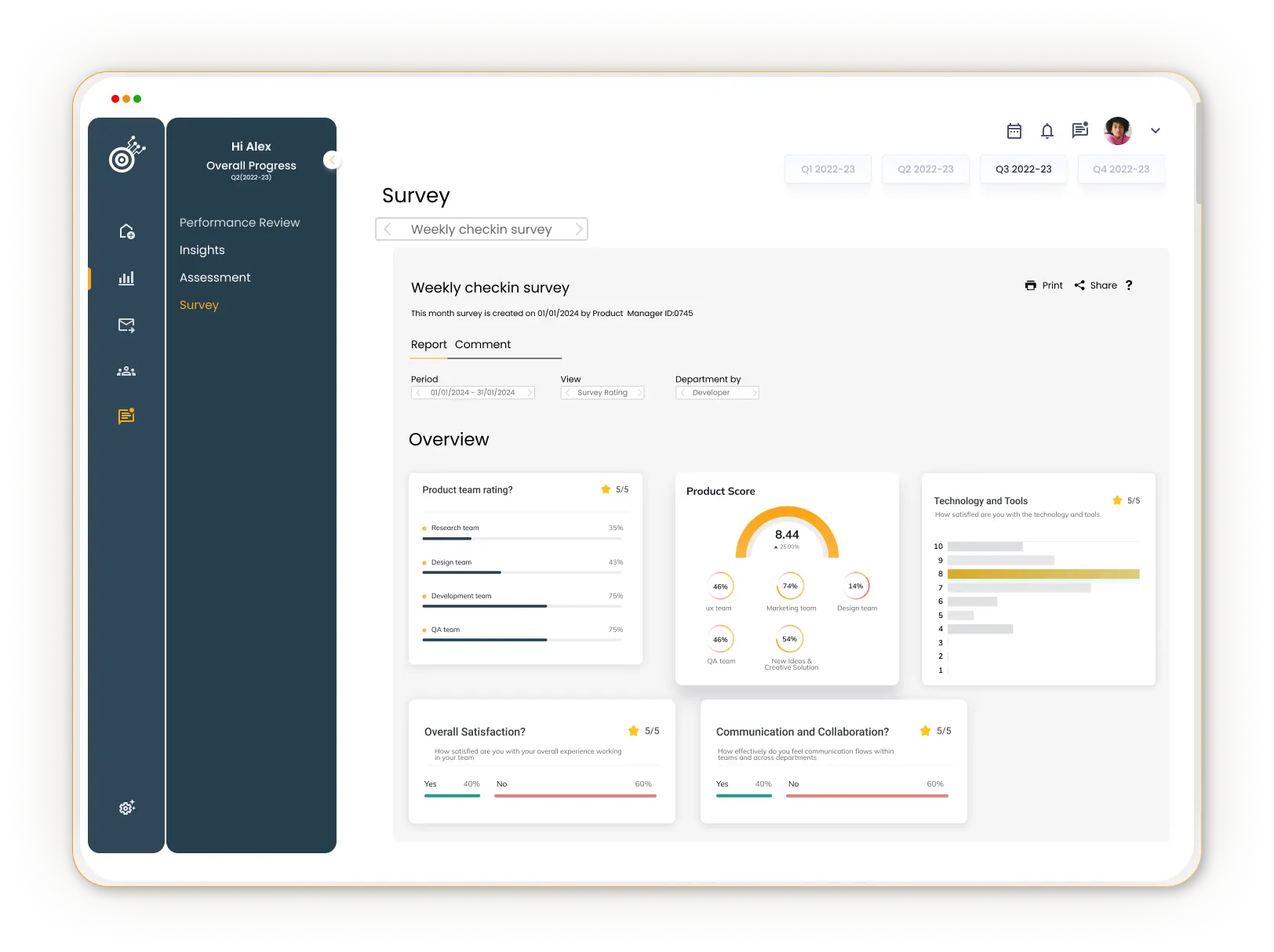
Integration Capabilities: A tool that seamlessly integrates with other HR systems (like payroll and learning management systems) ensures a unified approach to human resources management, enhancing both efficiency and data integrity.
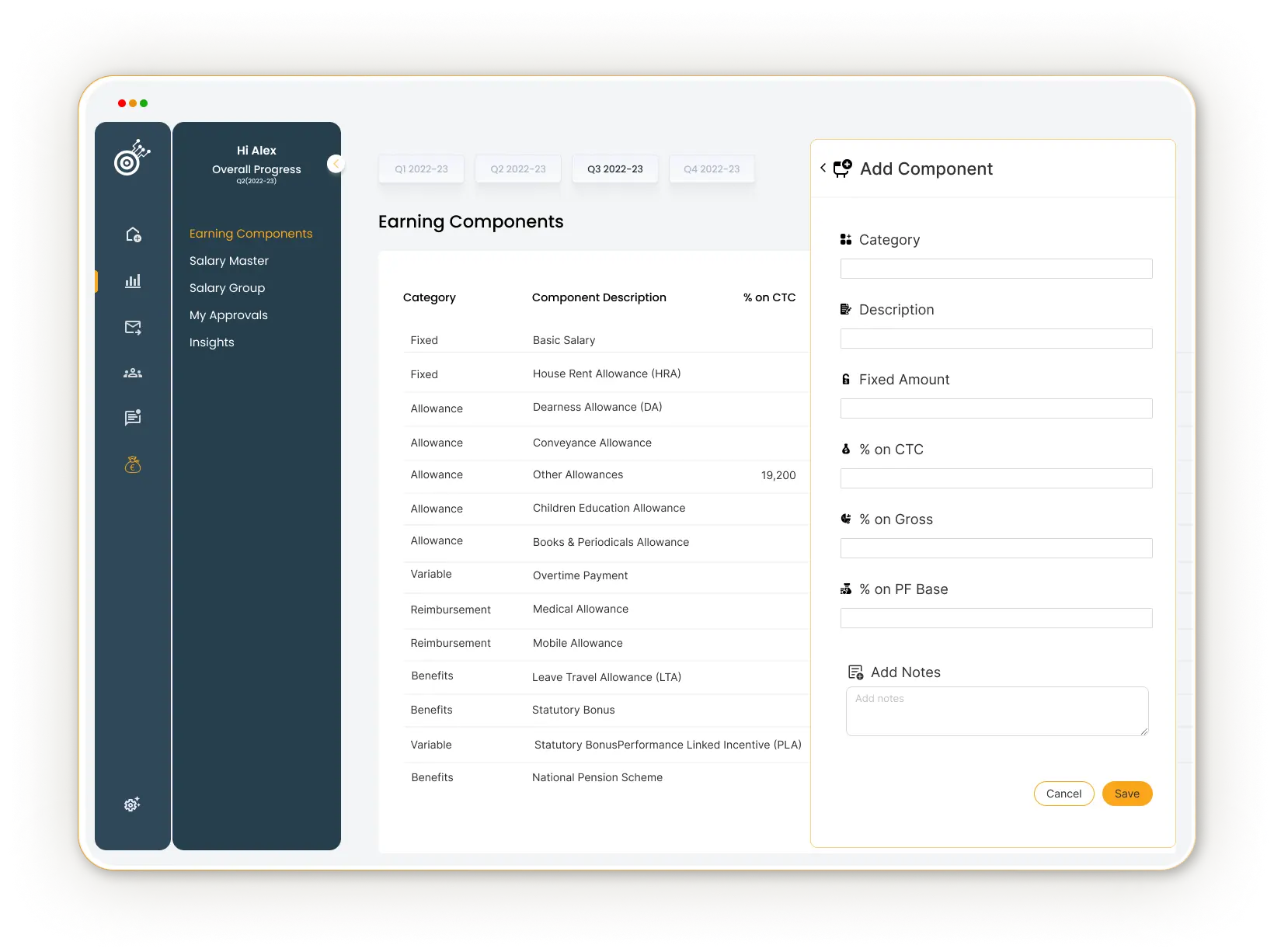
User-Friendly Interface: The effectiveness of a performance management tool is also dependent on its ease of use. Systems designed with a user-friendly interface ensure that both managers and employees can utilize them effectively, encouraging consistent use and engagement.

By implementing a robust performance management system like Datalligence, organizations can foster a culture of continuous improvement and accountability. Datalligence.ai provides a dynamic platform tailored to support the performance management planning process, aligning employee performance with strategic business objectives and driving organizational success.
Creating Performance Goals for Teams and Individuals
Creating effective performance goals for teams and individuals is crucial in driving both personal and organizational growth. These goals not only provide clarity and direction but also motivate and challenge team members to step out of their comfort zones and achieve remarkable results. By setting ambitious yet manageable goals, organizations can foster a culture of achievement and continuous improvement.
Employing the OKR Framework
Objectives and Key Results (OKRs) have been successfully used by leading companies worldwide to align team and individual efforts with corporate strategy. This framework involves setting a clear objective, which defines what you aim to achieve, paired with key results, which are measurable outcomes that track the success of that objective.
- Define Clear Objectives: Objectives should be ambitious and paint a clear picture of the desired future. They should inspire and challenge the team to push beyond their current capabilities.
- Identify Specific Key Results: Key results should be quantifiable and time-bound. They serve as benchmarks for measuring progress and success, ensuring that everyone knows what success looks like.
- Align OKRs with Company Vision: Ensure that each OKR aligns with the broader organizational goals. This alignment increases engagement as team members see how their efforts contribute to the company's success.
- Review and Adjust Regularly: OKRs are not set in stone. Regular check-ins allow teams to stay on track and make necessary adjustments to reflect changing priorities or unexpected challenges.
Setting Ambitious yet Achievable Objectives
Setting objectives that are both ambitious and achievable ensures that teams are motivated without being overwhelmed. These objectives should stretch the abilities of the team but remain within the realm of possibility to maintain engagement and prevent burnout.
- Break Down Large Goals: Large goals can be daunting. Breaking them down into smaller, actionable steps makes them more manageable and less intimidating. This also allows for quick wins that keep the team motivated.
- Use the SMART Criteria: Specific, Measurable, Achievable, Relevant, and Time-bound criteria help in setting clear and concise goals that are easier to understand and follow.
- Consider Individual and Team Capabilities: While setting high goals, it’s important to consider the current capabilities of your team. Provide training and resources needed to bridge the gap between current abilities and the demands of the goals.
- Encourage Ownership and Accountability: Allow team members to take ownership of their goals. This fosters a sense of responsibility and can lead to higher levels of commitment and performance.
- Celebrate Milestones: Recognizing and celebrating progress, no matter how small, can boost morale and encourage continued effort towards the goals.
Designing and Conducting Performance Reviews
Performance reviews, when conducted effectively, serve as a crucial tool in enhancing both organizational productivity and employee development. Opinions on the utility of performance reviews vary, with some viewing them as essential and others as outdated. However, the consensus remains that, when executed properly, they provide valuable insights into both company operations and employee experiences.
Best Practices for Performance Review Sessions
To ensure that performance reviews are productive and stress-free, it's important to design them around your company's core values and the individual goals of your employees. This alignment helps in driving the company mission forward while also supporting personal development. A well-conducted performance review should:
- Communicate clear expectations for each role.
- Identify strengths and areas for improvement.
- Highlight training opportunities and reward achievements.
- Foster alignment with the company’s mission.
- Support team cohesion and individual career advancement.
Using structured templates and performance review software can streamline the process, making it less time-consuming and more consistent. These tools allow for automated cycles and easy tracking of reviews, ensuring that both managers and employees spend less time on procedural tasks and more on meaningful discussion.
Frequency and Format of Reviews
The frequency and format of performance reviews can significantly impact their effectiveness. While traditional models recommended annual reviews, more dynamic approaches suggest more frequent interactions to address immediate feedback needs and support rapid development. Common practices include:
- Monthly Reviews: Especially beneficial for new employees or project-based teams who require regular guidance and quick adaptations.
- Quarterly Reviews: Ideal for providing a balance between frequent feedback and sufficient time for employees to work towards improvements.
- Annual Reviews: Useful for comprehensive overviews of progress and long-term planning, particularly in roles with extended project cycles.
Each organization should consider its unique needs and possibly employ a mixed approach, adapting the frequency and style of reviews according to different roles or departments. For instance, a tech team might benefit from quarterly reviews due to the fast-paced nature of the industry, while a research team might find annual reviews sufficient.
Incorporating various formats such as one-on-one meetings, 360-degree feedback, and real-time performance tracking can also enhance the effectiveness of the reviews. Face-to-face discussions are particularly valuable as they allow for honest and open communication, fostering stronger relationships and clearer understanding.
By integrating these practices and adjusting the review process to fit the specific needs of your organization, you can create a more engaged and motivated workforce. Employing tools like performance review software from companies like Datalligence can further enhance this process by providing customizable and scalable solutions that support continuous feedback and development.
Fostering Continuous Feedback and Communication
In today's fast-paced business environment, fostering continuous feedback and communication is crucial for maintaining high levels of employee engagement and organizational alignment. This section explores effective strategies to build a culture of ongoing feedback and utilize multiple channels for communication, ensuring that every employee feels connected and informed.
Building a Culture of Ongoing Feedback
Feedback is an indispensable tool in effective management, serving as a two-way channel that allows managers to gauge the impact of their decisions and provides employees with a platform to express their ideas and concerns. To cultivate a culture where feedback is continuous, consider the following approaches:
- Establish a Continuous Feedback Loop: Shift from traditional, periodic feedback models, like annual reviews, to a dynamic process where feedback is consistently collected, shared, and acted upon. This regular interaction fosters a more responsive and adaptive work environment.
- Encourage Regular Interactions: Implement regular one-on-one meetings and encourage informal feedback sessions. This helps in addressing issues promptly and maintaining a clear understanding of team and individual goals.
- Promote Transparency and Openness: Create an environment where employees feel safe to express their thoughts without fear of negative consequences. This openness increases trust and enhances the quality of feedback received.
- Utilize Digital Tools: Leverage platforms like performance management software that facilitate real-time feedback and seamless communication. Tools such as AllVoices, which allow for anonymous feedback, can also be instrumental in fostering a comprehensive feedback culture.
By integrating these practices, organizations can ensure that feedback becomes a cornerstone of daily operations, enhancing both individual and organizational growth.
Engaging and Motivating Employees throughout the Process
Recognition and Reward Systems
To foster a culture of engagement and appreciation within your organization, implementing effective recognition and reward systems is crucial. These systems not only celebrate employee achievements but also significantly boost morale and motivation. By publicly recognizing and rewarding employees who actively participate and contribute to the organizational goals, you emphasize the importance of their efforts. Consider adopting a rewards program like Bucketlist, which offers a vast array of personalized rewards and experiences, enhancing the perceived value of these recognitions among employees.
Recognition can take various forms, from public accolades in team meetings to formal awards at company events.
Additionally, tangible rewards such as bonuses, gift cards, or additional time off can be powerful incentives. These rewards should be linked directly to specific achievements and behaviors to reinforce the desired outcomes. For instance, team-based incentives have been shown to foster cooperation and boost overall performance more effectively than individual rewards.
Encouraging Employee Participation in Goal Setting
Employee participation in goal setting is a powerful strategy to enhance engagement and commitment. When employees are involved in setting their own objectives, they are more likely to be committed to these goals and motivated to achieve them. This participatory approach not only helps align individual aspirations with organizational objectives but also empowers employees by giving them a voice in their professional journey.
To implement this effectively, encourage your managers to work closely with their team members to set realistic and challenging goals. This collaboration should be an ongoing process, where goals are regularly reviewed and adjusted as needed. It's essential to maintain a low power distance in this process, allowing employees to feel valued and heard. Studies have shown that when employees perceive a lower power distance, their engagement and insider status within the company increase, leading to more proactive and innovative behaviors.
Moreover, regular check-ins on progress and continuous feedback are vital components of this process. These not only demonstrate managerial support for achieving the set goals but also provide opportunities for guidance and adjustments along the way. This ongoing dialogue helps to clarify expectations and fosters a supportive environment that is conducive to employee growth and satisfaction.
By integrating these strategies into your performance management planning process, particularly through platforms like Datalligence.ai, you can effectively enhance employee motivation and engagement, driving your organization toward its strategic objectives.
Evaluating and Adapting the Performance Management Plan
Throughout this article, we have traversed the multifaceted landscape of Performance Management Planning, elucidating its quintessential role in aligning individual achievements with organizational goals to unveil a pathway toward sustained growth and operational excellence. The stages of setting clear goals, meticulously appraising performance, and carefully crafting improvement plans denote the architecture of a successful Performance Management Plan. Implementing such a plan with precision is paramount for fostering an environment of continuous development and strategic fulfillment. By welcoming the principles of adaptability, regular assessment, and the cultivation of a feedback-rich culture, organizations can aspire to not only meet but exceed their operational benchmarks in an evolving business ecosystem.
As we conclude, it is apparent that the journey toward mastering Performance Management Planning is both strategic and iterative, demanding a balance between visionary goals and real-world practicalities. Employing Datalligence.ai in your strategic toolkit can provide much-needed leverage by streamlining the performance planning process and enhancing the efficacy of your performance management planning process.
Embrace a solution-based approach to Performance Management with Datalligence.ai, where technology meets strategy to empower your organization to navigate the complexities of performance enhancement while laying down robust foundations for future planning. To discover how Datalligence can transform your approach to Performance Management Planning, embark on your journey here. This strategic approach ensures that your organization remains agile, resilient, and perpetually aligned with its core objectives, paving the way for unparalleled success and innovation.











